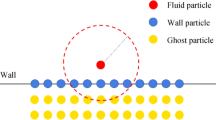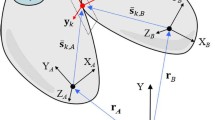Abstract
In Fluid Structure Interaction (FSI) problems encountered in marine hydrodynamics, the pressure field and the velocity of the rigid body are tightly coupled. This coupling is traditionally resolved in a partitioned manner by solving the rigid body motion equations once per nonlinear correction loop, updating the position of the body and solving the fluid flow equations in the new configuration. The partitioned approach requires a large number of nonlinear iteration loops per time–step. In order to enhance the coupling, a monolithic approach is proposed in Finite Volume (FV) framework, where the pressure equation and the rigid body motion equations are solved in a single linear system. The coupling is resolved by solving the rigid body motion equations once per linear solver iteration of the pressure equation, where updated pressure field is used to calculate new forces acting on the body, and by introducing the updated rigid body boundary velocity in to the pressure equation. In this paper the monolithic coupling is validated on a simple 2D heave decay case. Additionally, the method is compared to the traditional partitioned approach (i.e. “strongly coupled” approach) in terms of computational efficiency and accuracy. The comparison is performed on a seakeeping case in regular head waves, and it shows that the monolithic approach achieves similar accuracy with fewer nonlinear correctors per time–step. Hence, significant savings in computational time can be achieved while retaining the same level of accuracy.
Similar content being viewed by others
References
Bna S, Manservisi S, Aulisa E, 2013. A multilevel domain decomposition solver for monolithic fluid-structure interaction problems. 11th International Conference of Numerical Analysis and Applied Mathematics 2013, Pts 1 and 2, Vol. 1558. Rhodes, 871–874. DOI: 10.1063/1.4825635
Castiglione T, Stern F, Bova S, Kandasamy M, 2011. Numerical investigation of the seakeeping behavior of a catamaran advancing in regular head waves. Ocean Engineering, 38, 1806–1822. DOI: 10.1016/j.oceaneng.2011.09.003
Demirdžić I, Perić M, 1988. Space conservation law in finite volume calculations of fluid flow. International Journal for Numerical Methods in Fluids, 8(9), 1037–1050.
Eken A, Sahin M, 2016. A parallel monolithic algorithm for the numerical simulation of large-scale fluid structure interaction problems. International Journal for Numerical Methods in Fluids, 80(12), 687–714. DOI: 10.1002/fld.4169
Farah P, Vuong AT, Wall WA, Popp A, 2016. Volumetric coupling approaches for multiphysics simulations on nonmatching meshes. International Journal for Numerical Methods in Engineering, 108(12), 1550–1576. DOI: 10.1002/nme.5285
Hachem E, Feghali S, Codina R, Coupez T, 2013. Immersed stress method for fluidstructure interaction using anisotropic mesh adaptation. International Journal for Numerical Methods in Engineering, 94(9), 805–825. DOI: 10.1002/nme.4481
Heil M, Hazel AL, Boyle J, 2008. Solvers for large-displacement fluid-structure interaction problems: segregated versus monolithic approaches. Computational Mechanics, 43(1), 91–101. DOI: 10.1007/s00466-008-0270-6
Hu Z, Tang WY, Xue HX, Zhang XY, 2016. A simple-based monolithic implicit method for strong-coupled fluid-structure interaction problems with free surfaces. Computer Methods in Applied Mechanics and Engineering, 299, 90–115. DOI: 10.1016/j.cma.2015.09.011
Irons BM, Tuck RC, 1969. A version of the Aitken accelerator for computer iteration. International Journal for Numerical Methods in Engineering, 1, 275–277. DOI: 10.1002/nme.1620010306
Jasak H, 1996. Error analysis and estimation for the finite volume method with applications to fluid flows. PhD thesis, Imperial College of Science, Technology & Medicine, London.
Jasak H, Vukčević V, Gatin I, 2015. Numerical simulation of wave loads on static offshore structures. CFD for Wind and Tidal Offshore Turbines, 95–105.
Jog CS, Pal RK, 2011. A monolithic strategy for fluid-structure interaction problems. International Journal for Numerical Methods in Engineering, 85(4), 429–460. DOI: 10.1002/nme.2976
Langer U, Yang HD, 2016. Robust and efficient monolithic fluid-structure-interaction solvers. International Journal for Numerical Methods in Engineering, 108(4), 303–325. DOI: 10.1002/nme.5214
Larsson L, Stern F, Visonneau M, Hirata N, Hino T, Kim J, 2015. Tokyo 2015: A Workshop on CFD in Ship Hydrodynamics. Vol. 3, NMRI (National Maritime Research Institute), Tokyo, Japan.
Legay A, Zilian A, Janssen C, 2011. A rheological interface model and its space-time finite element formulation for fluid-structure interaction. International Journal for Numerical Methods in Engineering, 86(6), 667–687. DOI: 10.1002/nme.3060
Miyata H, Orihara H, Sato Y, 2014. Nonlinear ship waves and computational fluid dynamics. Proceedings of the Japan Academy Series B—Physical and Biological Sciences, 90, 278–300. DOI: 10.2183/pjab.90.278
Orihara H, Miyata H, 2003. Evaluation of added resistance in regular incident waves by computational fluid dynamics motion simulation using an overlapping grid system. Journal of Marine Science and Technology, 8, 47–60. DOI: 10.1007/s00773-003-0163-5
Press WH, Teukolsky SA, Vetterling WT, Flannery BP, 2002. Numerical Recipes in C++: The Art of Scientific Computing. Cambridge University Press, Cambridge.
Robinson-Mosher A, Schroeder C, Fedkiw R, 2011. A symmetric positive definite formulation for monolithic fluid structure interaction. Journal of Computational Physics, 230(4), 1547–1566. DOI: 10.1016/j.jcp.2010.11.021
Saad Y, 2003. Iterative methods for sparse linear systems. 2nd edition, Society for Industrial and Applied Mathematics Philadelphia.
Simonsen CD, Otzen JF, Joncquez S, Stern F, 2013. EFD and CFD for KCS heaving and pitching in regular head waves. Journal of Marine Science and Technology, 18, 435–459. DOI: 10.1007/s00773-013-0219-0
Tezdogan T, Demirel YK, Kellett P, Khorasanchi M, Incecik A, Turan O, 2015. Full-scale unsteady RANS CFD simulations of ship behaviour and performance in head seas due to slow steaming. Ocean Engineering, 97, 186–206. DOI: 10.1016/j.oceaneng.2015.01.011
Vukčević V, 2016. Numerical modelling of coupled potential and viscous flow for marine applications. PhD thesis, Faculty of Mechanical Engineering and Naval Architecture, University of Zagreb.
Vukčević V, Jasak H, 2015a. Seakeeping validation and verification using decomposition model based on embedded free surface method. Tokyo 2015: A Workshop on CFD in Ship Hydrodynamics.
Vukčević V, Jasak H, 2015b. Validation and verification of decomposition model based on embedded free surface method for oblique wave seakeeping simulations. Tokyo 2015: A Workshop on CFD in Ship Hydrodynamics.
Vukčević V, Jasak H, Gatin I, Malenica S, 2016. Seakeeping sensitivity studies using the decomposition CFD model based on the ghost fluid method. Proceedings of the 31st Symposium on Naval Hydrodynamics, Monterey.
Vukčević V, Jasak H, Malenica S, 2016a. Decomposition model for naval hydrodynamic applications, Part I: Computational method. Ocean Eng., 121, 37–46. DOI: 10.1016/j.oceaneng.2016.05.022
Vukčević V, Jasak H, Malenica S, 2016b. Decomposition model for naval hydrodynamic applications, Part II: Verification and validation. Ocean Eng., 121, 76–88. DOI: 10.1016/j.oceaneng.2016.05.021
Wu CS, Zhou DC, Gao L, Miao QM, 2011. CFD computation of ship motions and added resistance for a high speed trimaran in regular head waves. International Journal of Naval Architecture and Ocean Engineering, 3, 105–110. DOI: 10.3744/jnaoe.2011.3.1.105
Yang P, Xiang J, Fang F, Pavlidis D, Latham JP, Pain CC, 2016. Modelling of fluid-structure interaction with multiphase viscous flows using an immersed-body method. Journal of Computational Physics, 321, 571–592. DOI: 10.1016/j.jcp.2016.05.035
Acknowledgements
This research was sponsored by Bureau Veritas under the administration of Dr. Šime Malenica.
Author information
Authors and Affiliations
Corresponding author
Rights and permissions
About this article
Cite this article
Jasak, H., Gatin, I. & Vukčević, V. Monolithic coupling of the pressure and rigid body motion equations in computational marine hydrodynamics. J. Marine. Sci. Appl. 16, 375–381 (2017). https://doi.org/10.1007/s11804-017-1436-4
Received:
Accepted:
Published:
Issue Date:
DOI: https://doi.org/10.1007/s11804-017-1436-4




